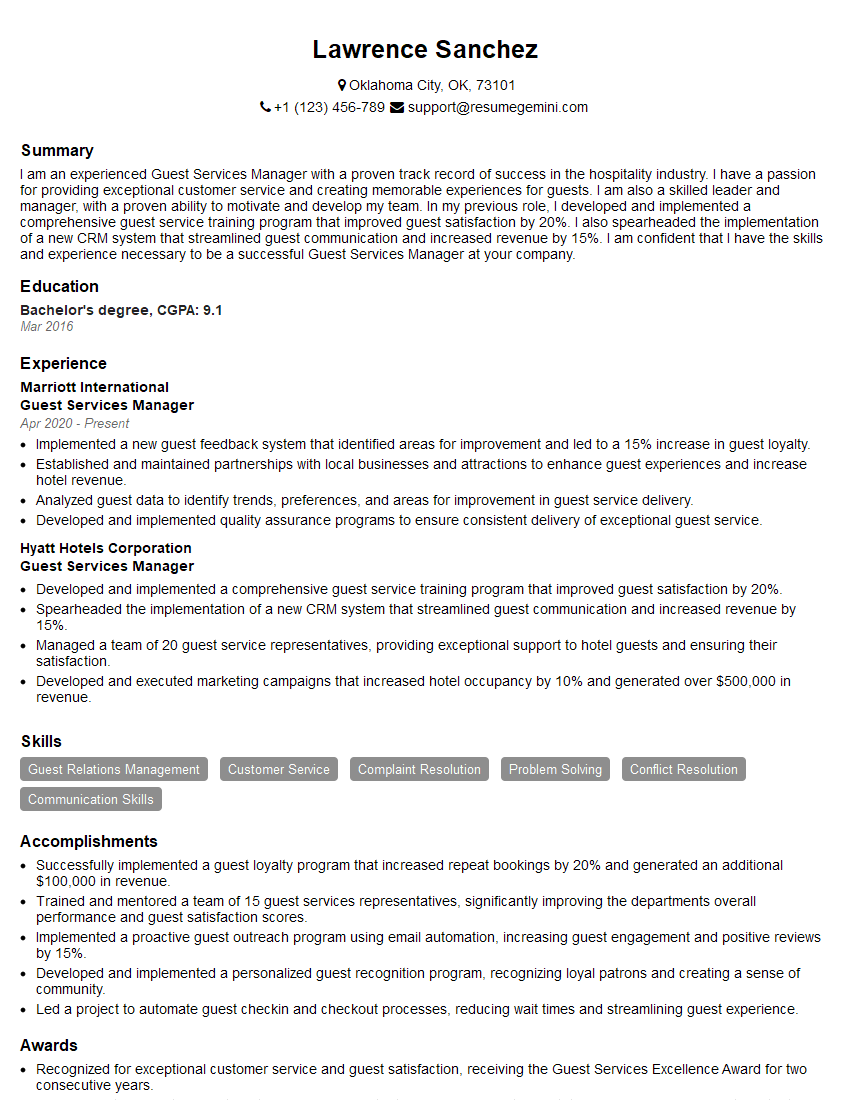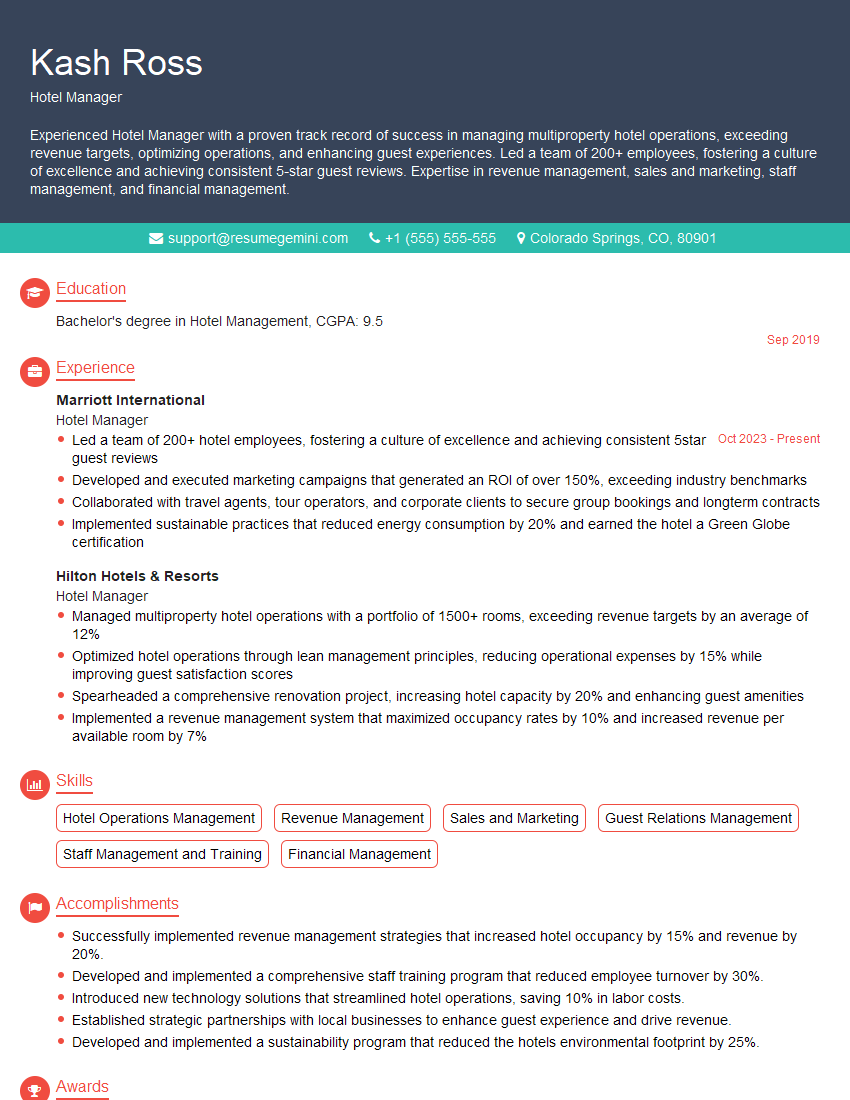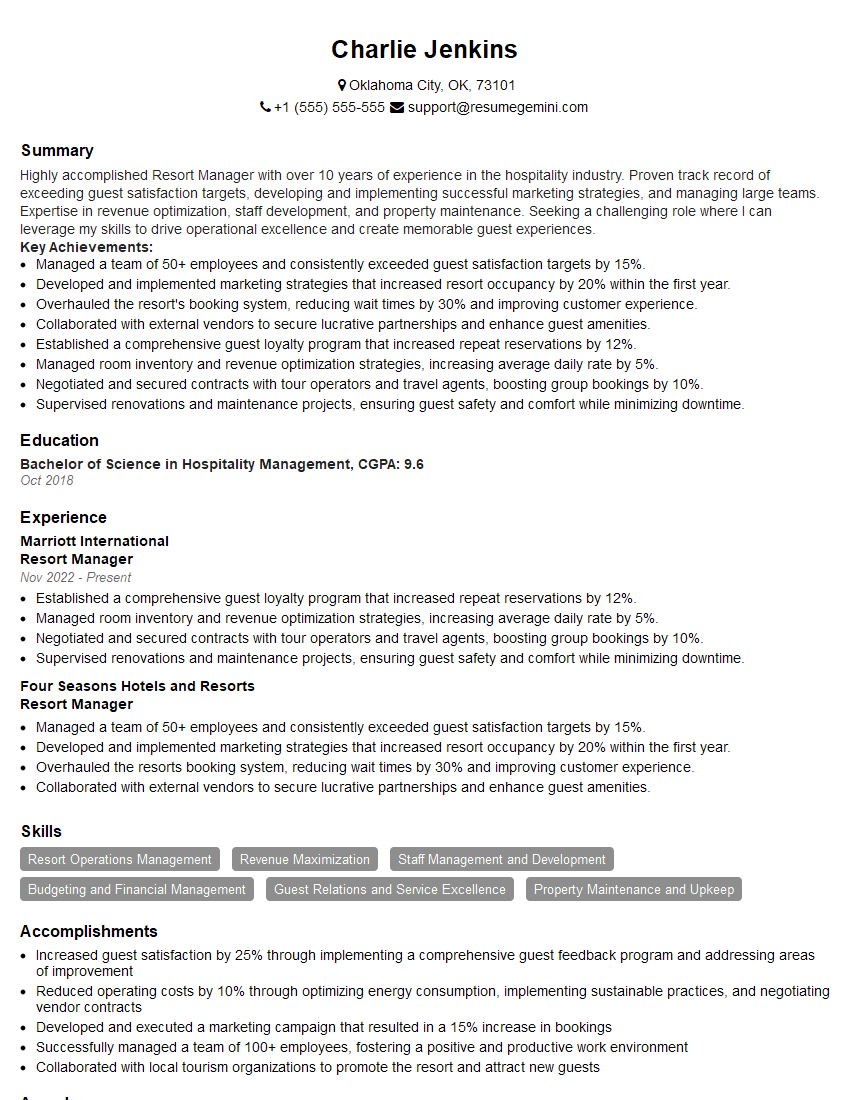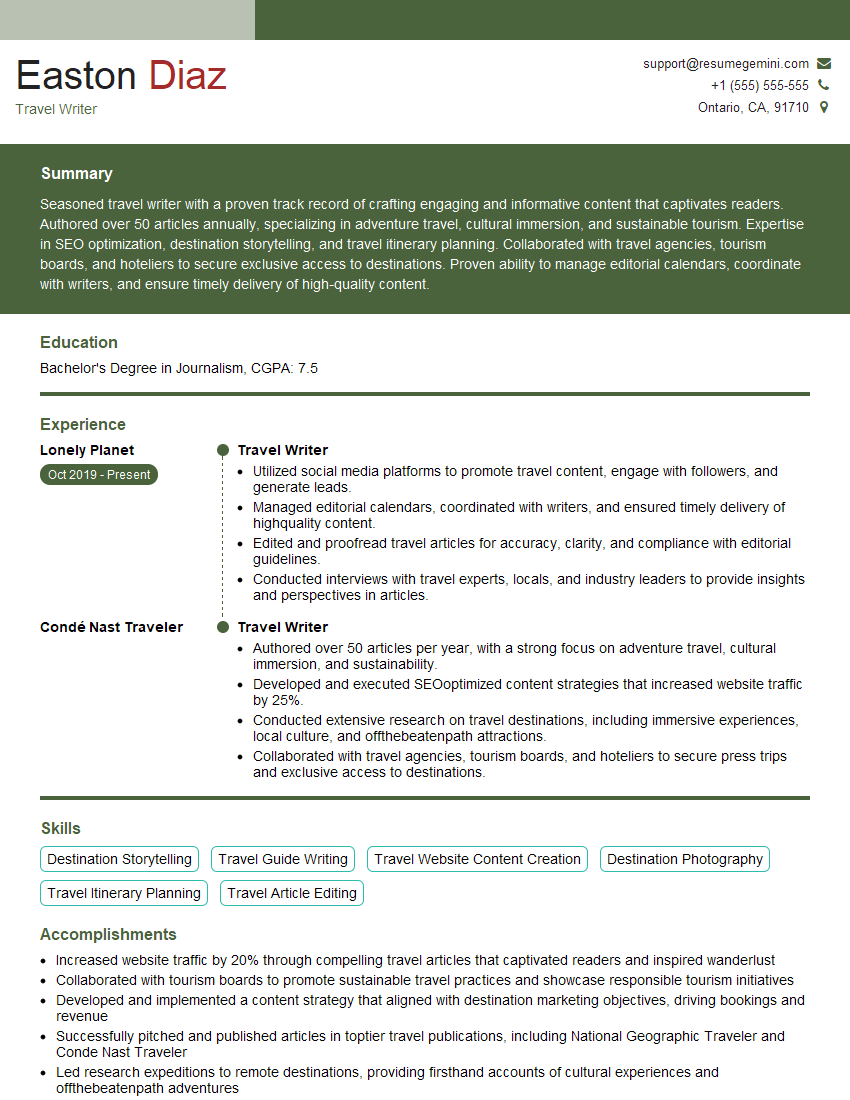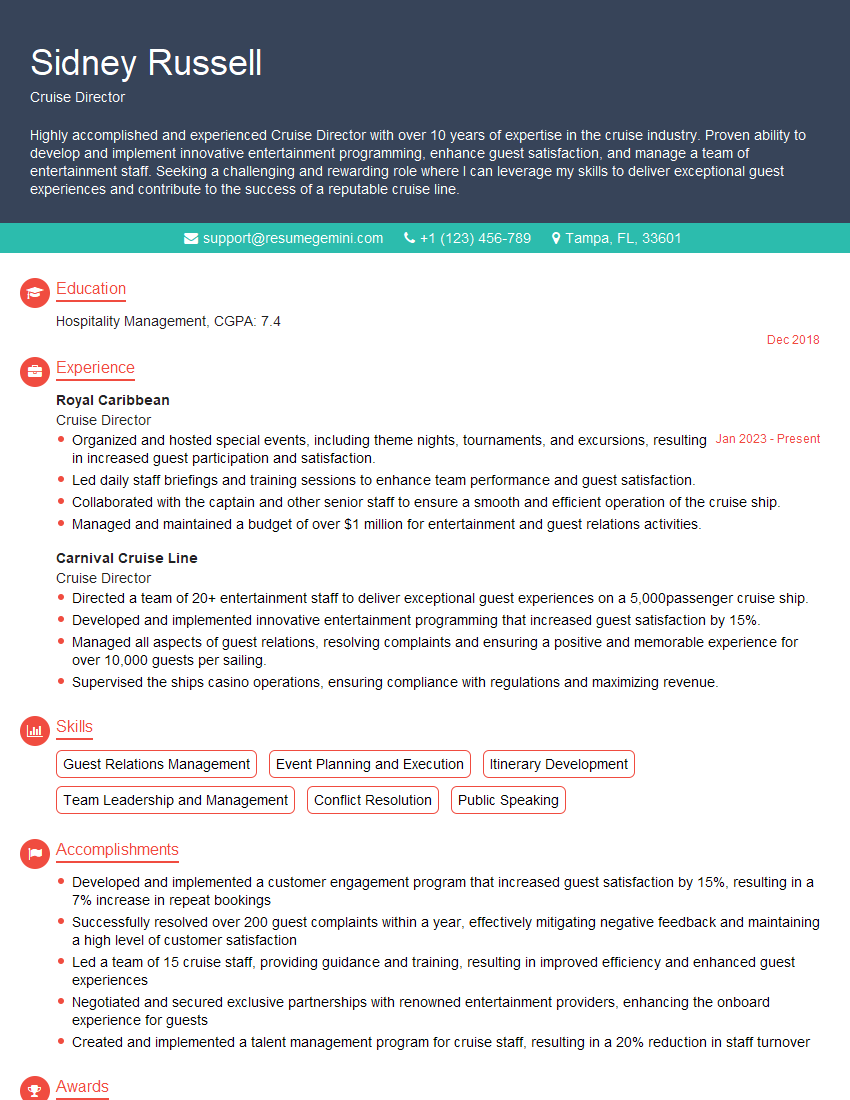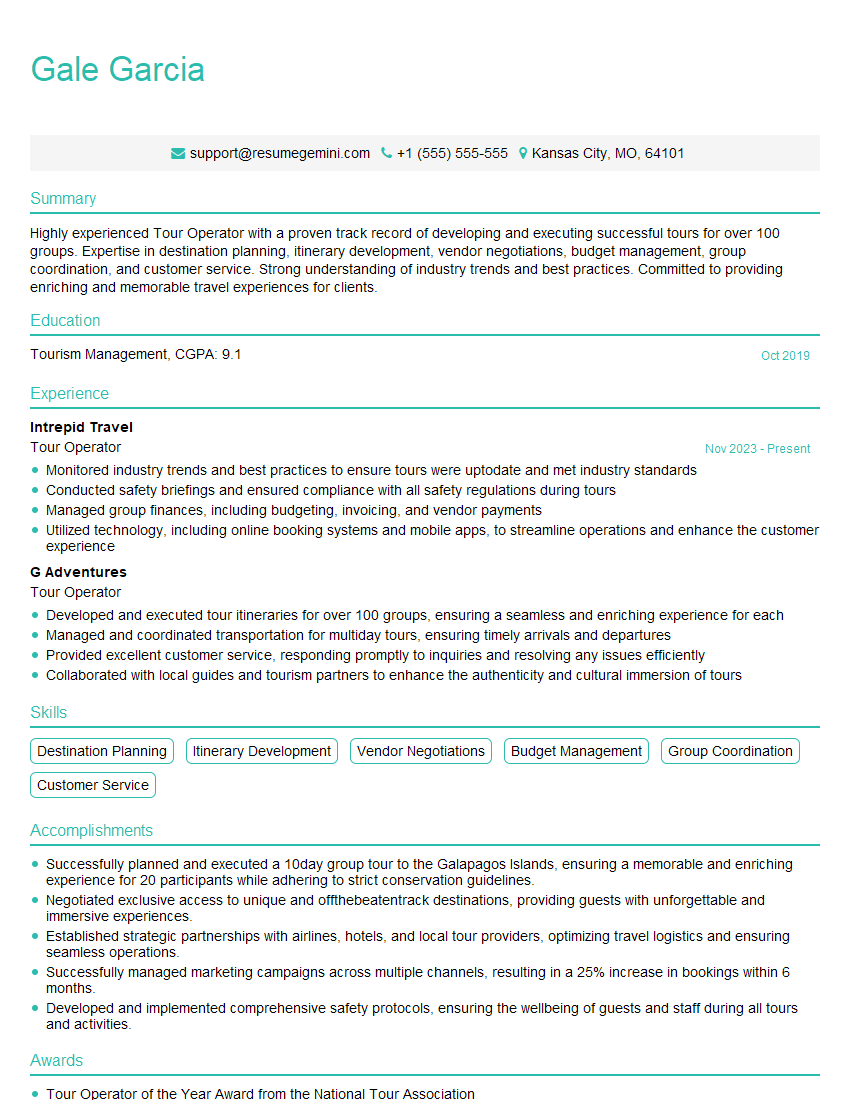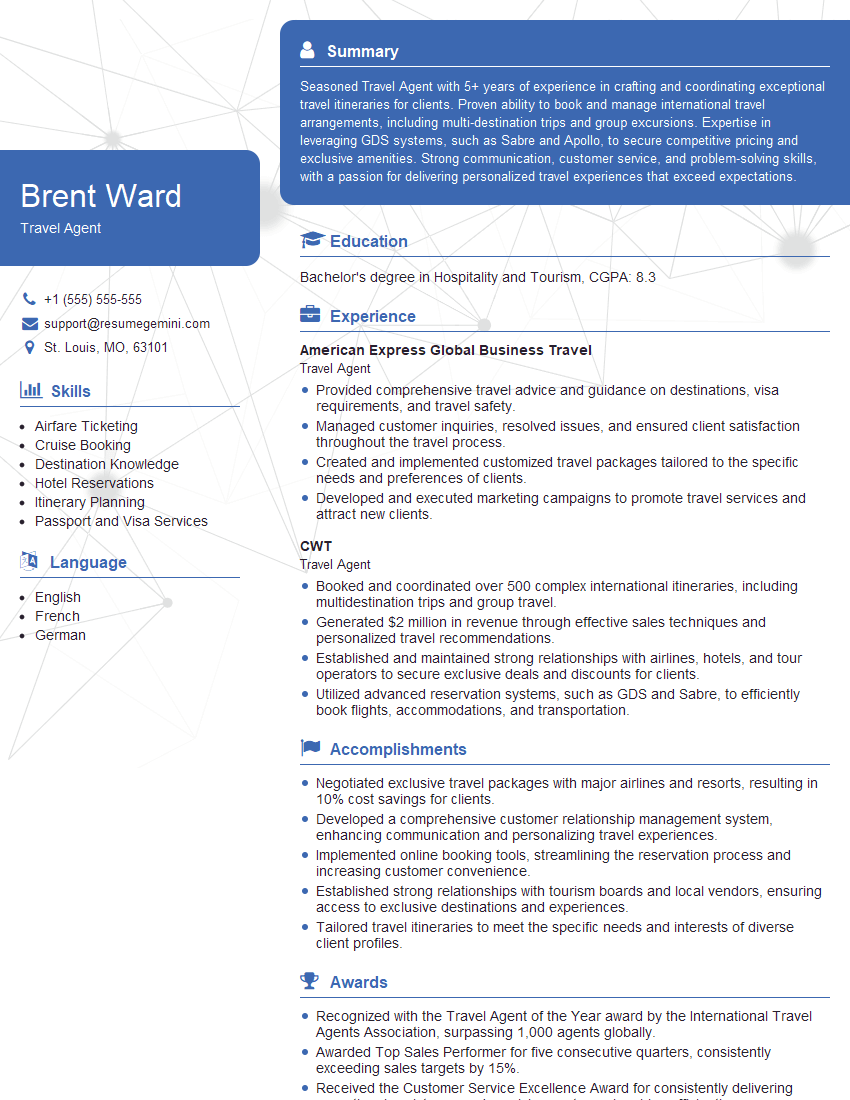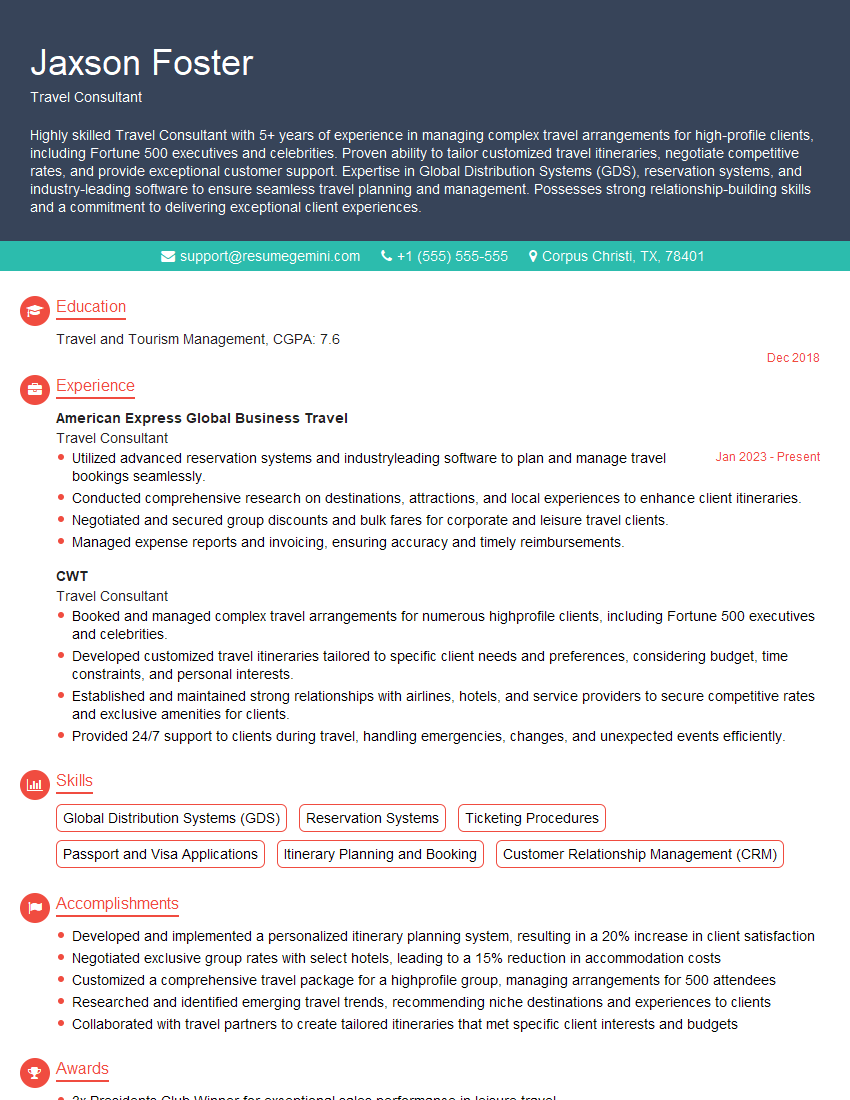Every successful interview starts with knowing what to expect. In this blog, we’ll take you through the top Passion for Travel and Tourism interview questions, breaking them down with expert tips to help you deliver impactful answers. Step into your next interview fully prepared and ready to succeed.
Questions Asked in Passion for Travel and Tourism Interview
Q 1. Describe your understanding of the current trends in the travel and tourism industry.
The travel and tourism industry is experiencing a period of dynamic change, driven by several key trends. Sustainability is paramount; travelers are increasingly seeking eco-friendly options and businesses are responding with carbon-offsetting programs, sustainable tourism certifications, and eco-lodges. Technology plays a crucial role, with the rise of online travel agencies (OTAs), personalized travel planning tools, and the use of mobile apps for booking, navigation, and in-destination experiences. Experiential travel is also a major force, with a shift from sightseeing to immersive activities and authentic cultural interactions. This includes things like voluntourism, culinary tourism, and adventure travel. Finally, we’re seeing a rise in bleisure travel (a blend of business and leisure) and the increasing importance of safety and security concerns, especially following recent global events.
- Example: The growing popularity of slow travel, focusing on fewer destinations and deeper immersion, reflects the shift towards experiential travel.
- Example: The success of apps like Airbnb and Booking.com highlights the impact of technology on booking and accommodation.
Q 2. How would you handle a difficult customer complaint in a travel agency setting?
Handling a difficult customer complaint requires a calm, empathetic, and solution-oriented approach. My first step would be to actively listen to the customer, allowing them to fully express their concerns without interruption. I would validate their feelings by acknowledging their frustration and demonstrating understanding. Then, I would apologize for the inconvenience, regardless of who was at fault. This shows respect and goodwill. Next, I’d gather all the necessary information to understand the issue fully. This might involve checking booking details, contacting the relevant supplier (hotel, airline, etc.), and carefully reviewing any applicable terms and conditions. Finally, I would propose a fair and reasonable solution, perhaps offering a refund, compensation (like a discount on a future trip), or an upgrade. If the situation is particularly complex, I would document everything thoroughly and escalate it to a supervisor if necessary.
Example: If a customer’s flight was canceled due to unforeseen circumstances, I would first empathize with their frustration, then explore options like rebooking on a different airline or offering a hotel stay and compensation for the disruption. Thorough documentation of the situation is crucial in such cases.
Q 3. Explain your experience with different customer relationship management (CRM) systems.
I have extensive experience with several CRM systems, including Salesforce, Zoho CRM, and HubSpot. My experience spans data entry, lead management, customer segmentation, and reporting. I’m proficient in using CRM systems to track customer interactions, manage bookings, personalize communications, and analyze customer data to improve service and marketing strategies. For instance, I used Salesforce to track customer preferences, ensuring personalized travel recommendations and follow-up communications. I also utilized Zoho CRM for managing client databases, scheduling appointments, and automating tasks, which significantly increased efficiency. My skills extend to integrating CRM data with other systems for a holistic view of the customer journey.
Example: Using Salesforce, I segmented customers based on their travel history (e.g., luxury vs. budget travelers) to send targeted marketing materials and tailor their travel experiences.
Q 4. What are your strategies for marketing a new tourism destination?
Marketing a new tourism destination requires a multi-faceted approach. Firstly, identifying the target audience is crucial – are we targeting adventure seekers, families, luxury travelers, or cultural enthusiasts? Once identified, we can craft a compelling brand story that highlights the destination’s unique selling points (USPs). This could involve showcasing stunning landscapes, unique cultural experiences, or historical significance. We’d leverage various marketing channels, including social media (Instagram, Facebook, TikTok for visuals; blogs and articles for detailed information) public relations (press releases, media partnerships), content marketing (blog posts, videos, infographics), and influencer marketing (collaborating with travel bloggers or influencers who align with the target audience). Search engine optimization (SEO) and paid advertising (PPC) are essential for online visibility. Finally, we’d measure the campaign’s effectiveness through key performance indicators (KPIs) like website traffic, social media engagement, and booking numbers, adjusting the strategy based on data-driven insights.
Example: To market a new eco-tourism destination, we’d focus on creating visually stunning content highlighting its natural beauty and sustainable practices, targeting environmentally conscious travelers on platforms like Instagram and partnering with relevant influencers.
Q 5. How familiar are you with various booking platforms and reservation systems?
I’m highly familiar with a wide range of booking platforms and reservation systems, including OTAs like Expedia and Booking.com, Global Distribution Systems (GDS) like Amadeus and Sabre, and property management systems (PMS) commonly used by hotels. My experience encompasses using these systems for booking flights, accommodations, tours, and other travel services, as well as managing reservations, processing payments, and handling cancellations. I understand the intricacies of different system interfaces and can navigate them efficiently to provide seamless booking experiences for clients.
Example: I’ve used Amadeus to book complex international itineraries, including multiple flights and connecting transfers, ensuring optimal flight routes and pricing for clients. I’ve also utilized Booking.com to manage hotel bookings and communicate with suppliers regarding reservations.
Q 6. Discuss your experience with developing and implementing tourism marketing campaigns.
I have extensive experience developing and implementing tourism marketing campaigns, from initial concept to final analysis. This involves conducting thorough market research to understand the target audience, competitive landscape, and destination’s unique selling points. Based on this research, I create a comprehensive marketing plan outlining objectives, target audience, strategies, budget, and timeline. I’ve successfully managed campaigns using various channels, including social media, email marketing, content marketing, and paid advertising. I’ve developed marketing materials including brochures, website content, and social media posts. I track campaign performance using analytics tools like Google Analytics to monitor key metrics such as website traffic, conversion rates, and ROI. This data helps refine strategies to optimize campaign effectiveness.
Example: I spearheaded a campaign for a historical city, leveraging storytelling through compelling videos and blog posts, targeting history buffs and culture enthusiasts. This campaign resulted in a significant increase in tourist arrivals.
Q 7. How do you stay updated on the latest travel advisories and safety regulations?
Staying updated on travel advisories and safety regulations is critical in the travel industry. I regularly monitor official government websites like the U.S. Department of State’s travel advisories, the UK Foreign, Commonwealth & Development Office, and similar organizations in other countries. I also subscribe to travel industry news sources and alerts from organizations like the World Health Organization (WHO) to stay informed about potential health risks. I utilize travel safety apps and resources to assess real-time risks, and actively communicate any important updates to clients to ensure their safety and well-being. I integrate this information into the trip planning process, ensuring that clients are fully aware of any potential safety concerns and necessary precautions.
Example: Before booking a trip to a region with a recent health advisory, I would communicate the details to the client, assess their risk tolerance, and suggest alternative destinations if necessary.
Q 8. Describe your approach to sustainable and responsible tourism.
My approach to sustainable and responsible tourism centers around the principle of minimizing negative impacts and maximizing positive contributions to the environment, local economies, and cultures. It’s not just about ticking boxes; it’s about integrating ethical considerations into every aspect of the travel experience.
- Environmental Sustainability: This involves promoting eco-friendly accommodations, reducing carbon emissions through responsible transportation choices (e.g., prioritizing trains over planes where feasible, supporting electric vehicle initiatives), minimizing waste, and conserving resources like water and energy. For example, I’d advocate for hotels that use renewable energy sources and implement robust recycling programs.
- Socio-economic Sustainability: Supporting local communities is paramount. This means choosing locally owned businesses, participating in community-based tourism initiatives, and ensuring that the economic benefits of tourism are fairly distributed. An example would be recommending tourists visit locally owned restaurants and artisan shops instead of large international chains.
- Cultural Preservation: Respecting local customs and traditions is crucial. This involves educating travelers on appropriate behavior, supporting the preservation of cultural heritage sites, and avoiding activities that could contribute to cultural commodification. I’d encourage respectful interaction with locals and discourage practices like taking photos without permission in culturally sensitive situations.
- Responsible Travel Practices: This includes encouraging responsible wildlife tourism (no interactions that endanger animals), promoting ethical sourcing of souvenirs, and avoiding over-tourism in fragile ecosystems. A specific example is promoting wildlife viewing tours that are led by local guides and adhere to strict guidelines to protect animals.
Ultimately, my approach is about creating a holistic strategy where environmental protection, social equity, and economic viability work in harmony. It’s about building a tourism industry that thrives without compromising the well-being of future generations and local communities.
Q 9. Explain your understanding of the importance of cultural sensitivity in the tourism industry.
Cultural sensitivity is the cornerstone of responsible tourism. It’s about understanding and respecting the diverse cultures we encounter while traveling, recognizing that different societies have varying customs, beliefs, and values.
Ignoring cultural nuances can lead to misunderstandings, offense, and even damage to local communities. For example, certain gestures considered polite in one culture might be offensive in another. Similarly, inappropriate clothing choices or a lack of understanding regarding local religious practices can create friction.
My approach to cultural sensitivity includes:
- Research and Education: Before planning any trip, I thoroughly research the local culture, customs, and etiquette of the destination. This includes understanding local traditions, dress codes, and appropriate greetings.
- Respectful Interactions: I emphasize respectful communication with locals, always seeking permission before taking photographs, learning a few basic phrases in the local language, and being mindful of personal space.
- Support for Local Culture: I promote participation in cultural activities that benefit local communities, such as attending local events, supporting local artists, and purchasing ethically sourced souvenirs.
- Avoiding Cultural Commodification: I discourage activities that exploit local cultures or turn them into mere spectacles for tourists. This means being mindful of the impact of my actions and choices on local communities.
In essence, cultural sensitivity isn’t just about being polite; it’s about demonstrating genuine respect for the rich tapestry of human experience, ensuring that tourism enriches local cultures rather than eroding them.
Q 10. What are your skills in analyzing tourism data and market research?
My skills in analyzing tourism data and market research are built on a foundation of statistical analysis, market trend identification, and data visualization. I’m proficient in utilizing various tools and techniques to gather, interpret, and present actionable insights.
My approach involves:
- Data Collection: I utilize a variety of sources, including secondary data (like government reports, industry publications, and market research databases) and primary data (through surveys, focus groups, and interviews).
- Data Analysis: I employ statistical methods (like regression analysis, hypothesis testing, and time series analysis) to identify trends, patterns, and correlations within tourism data. I also use qualitative analysis to understand underlying motivations and behaviors.
- Market Segmentation: I segment markets based on various demographics, psychographics, and behavioral characteristics to tailor marketing campaigns and develop targeted tourism products.
- Competitive Analysis: I conduct thorough competitive analyses to understand the strengths and weaknesses of competitors, identify market opportunities, and develop effective strategies for differentiation.
- Data Visualization: I use data visualization tools to present complex information clearly and effectively, allowing for easier interpretation and communication of insights to stakeholders.
For example, I might use data analysis to understand the peak tourist seasons for a specific destination, identify the demographics of the most frequent visitors, and then use this information to create targeted marketing materials or develop new tour packages.
Q 11. How would you design an itinerary for a specific target group (e.g., families, adventure seekers)?
Designing an itinerary requires a deep understanding of the target group’s needs, preferences, and limitations. For families, the focus is on creating a fun, engaging, and manageable experience. For adventure seekers, the emphasis shifts to thrilling activities and challenging experiences.
Example: Family Itinerary (5 days in Costa Rica):
- Day 1: Arrival in San Jose, transfer to a family-friendly hotel near Pacuare River Lodge. Relaxing afternoon, introduction to Costa Rican nature.
- Day 2: Guided nature walk exploring the rainforest, spotting sloths and monkeys. Gentle river tubing experience, suitable for all ages.
- Day 3: Visit to a local wildlife sanctuary, interactive experience learning about Costa Rican animals. Evening at a family-friendly restaurant with traditional Costa Rican food.
- Day 4: Trip to La Paz Waterfall Gardens, exploring stunning waterfalls and observing diverse wildlife. Relaxing afternoon at the hotel.
- Day 5: Departure from San Jose.
Example: Adventure Seeker Itinerary (5 days in Nepal):
- Day 1: Arrival in Kathmandu, acclimatization walk around the city, preparation for trekking.
- Day 2: Flight to Lukla, trek to Phakding, enjoying the stunning mountain scenery.
- Day 3: Trekking to Namche Bazaar, acclimatization hike to Everest View Hotel for panoramic views.
- Day 4: Acclimatization day in Namche Bazaar, exploring Sherpa culture and local markets.
- Day 5: Trek back to Lukla, flight back to Kathmandu.
In both cases, the itinerary would be further refined based on specific family needs (ages of children, special needs) or adventure seeker preferences (experience level, preferred activities).
Q 12. Explain your experience with managing budgets and resources in a travel-related context.
My experience in managing budgets and resources in the travel industry involves meticulous planning, cost-effective strategies, and efficient resource allocation. This includes negotiating favorable rates with vendors, tracking expenses diligently, and making data-driven decisions to maximize ROI.
I’ve been involved in:
- Budget Creation and Monitoring: Developing comprehensive budgets based on projected costs, revenue streams, and contingency planning. Regularly tracking expenses against the budget to identify potential variances and take corrective actions.
- Vendor Negotiation: Negotiating competitive rates with airlines, hotels, tour operators, and other travel vendors to secure the best value for money.
- Resource Allocation: Efficiently allocating resources (staff, equipment, marketing budget) to maximize productivity and achieve business objectives. This includes prioritizing tasks based on their impact and urgency.
- Financial Reporting: Preparing regular financial reports to track performance, identify areas for improvement, and make informed business decisions.
For example, in a recent project, I successfully negotiated a 15% discount on hotel bookings by leveraging my knowledge of industry trends and competitive pricing. This resulted in significant cost savings for the project without compromising quality.
Q 13. How do you prioritize tasks and manage time effectively in a fast-paced travel environment?
The fast-paced travel environment demands effective time management and prioritization skills. I utilize several strategies to manage my workload efficiently and meet deadlines.
- Prioritization Frameworks: I employ prioritization frameworks like the Eisenhower Matrix (urgent/important) to identify high-impact tasks and delegate or defer lower priority items.
- Time Blocking: I allocate specific time blocks for different tasks, minimizing distractions and enhancing focus.
- Project Management Tools: I utilize project management tools (like Trello or Asana) to track progress, manage deadlines, and collaborate effectively with team members.
- Proactive Planning: I engage in proactive planning by anticipating potential challenges and developing contingency plans, thereby minimizing disruptions.
- Delegation: I effectively delegate tasks to team members, leveraging their strengths and ensuring efficient workload distribution.
For instance, if I have multiple urgent tasks to complete before a tour departs, I’ll use the Eisenhower Matrix to prioritize critical tasks like confirming flight bookings and arranging transportation over less urgent items like finalizing souvenir lists.
Q 14. Describe your experience in resolving conflicts or disagreements within a team.
Resolving conflicts within a team is a crucial aspect of effective teamwork. My approach focuses on open communication, empathy, and finding mutually acceptable solutions.
My steps to conflict resolution include:
- Active Listening: I actively listen to all parties involved, ensuring everyone feels heard and understood. This helps identify the root cause of the conflict.
- Empathy and Understanding: I try to understand each person’s perspective, acknowledging their feelings and concerns.
- Collaborative Problem Solving: I facilitate a collaborative process where all parties work together to identify mutually acceptable solutions. This may involve brainstorming, compromise, or mediation.
- Focus on Solutions, not Blame: I focus on finding solutions rather than assigning blame. This helps maintain positive relationships within the team.
- Documentation and Follow-up: I document agreements and follow up to ensure that solutions are implemented and the conflict doesn’t resurface.
For example, in a situation where two team members had a disagreement about the itinerary for a particular tour, I facilitated a discussion where each member explained their reasoning. We collaboratively revised the itinerary to incorporate aspects from both plans, resulting in a solution that satisfied everyone involved.
Q 15. What are your strategies for building strong relationships with clients and partners?
Building strong client and partner relationships is the cornerstone of success in the travel and tourism industry. It’s about fostering trust, understanding their needs, and consistently exceeding expectations. My strategy is multifaceted:
- Proactive Communication: I believe in regular, transparent communication. This includes prompt responses to inquiries, proactive updates on bookings and travel plans, and open dialogue addressing any concerns. For example, I’d regularly check in with clients before, during, and after their trip, sharing relevant information and offering assistance.
- Personalized Service: I tailor my services to each client’s unique preferences and travel style. Understanding their priorities – whether it’s luxury, adventure, budget travel, or cultural immersion – is crucial to crafting a truly memorable experience. I remember once customizing a honeymoon itinerary for a couple based on their love for hiking and photography, resulting in an unforgettable trip to Patagonia.
- Relationship Building: I invest time in getting to know my clients and partners personally. This goes beyond transactional interactions. It involves building genuine rapport and understanding their long-term goals. With partners, this means attending industry events, collaborating on joint marketing efforts, and consistently delivering on agreements.
- Problem Solving: Inevitably, challenges arise. My commitment is to proactively address any issues and find creative solutions that satisfy both the client and the partner. A recent example involved resolving a flight cancellation by securing alternate travel arrangements that were even more suitable for the client’s needs.
Career Expert Tips:
- Ace those interviews! Prepare effectively by reviewing the Top 50 Most Common Interview Questions on ResumeGemini.
- Navigate your job search with confidence! Explore a wide range of Career Tips on ResumeGemini. Learn about common challenges and recommendations to overcome them.
- Craft the perfect resume! Master the Art of Resume Writing with ResumeGemini’s guide. Showcase your unique qualifications and achievements effectively.
- Don’t miss out on holiday savings! Build your dream resume with ResumeGemini’s ATS optimized templates.
Q 16. Explain your familiarity with different types of tourism (e.g., ecotourism, adventure tourism, cultural tourism).
I’m familiar with a wide range of tourism types, understanding their nuances and target markets. Let’s explore a few:
- Ecotourism: This focuses on responsible travel to natural areas, conserving the environment and improving the well-being of local people. It involves minimizing the environmental impact and maximizing the positive socio-economic benefits for the host communities. For example, supporting locally owned eco-lodges and participating in community-based conservation projects.
- Adventure Tourism: This involves activities like hiking, trekking, white-water rafting, and rock climbing. It caters to thrill-seekers who want to push their limits in spectacular natural settings. Risk assessment and safety protocols are paramount in this sector. I’ve planned numerous adventure tours, ensuring appropriate safety measures and briefing participants thoroughly.
- Cultural Tourism: This involves exploring the history, art, cuisine, and traditions of a destination. It aims to foster understanding and respect for different cultures. I’ve planned trips that incorporate visits to historical sites, museums, local markets, and opportunities to interact with local communities, providing cultural sensitivity training to ensure respectful engagement.
Understanding these diverse types allows me to curate unique and tailored experiences that cater to specific interests and preferences.
Q 17. How would you handle a crisis situation, such as a natural disaster or travel disruption?
Crisis management is a critical skill in the travel industry. My approach involves a structured response:
- Immediate Assessment: Quickly gather information about the nature and extent of the crisis (e.g., natural disaster, political unrest, travel disruption). This involves contacting clients, partners, and relevant authorities.
- Client Communication: Proactively contact all affected clients, providing updates, reassurance, and clear instructions. Transparency is key during a crisis.
- Problem Solving: Collaborate with partners (hotels, airlines, ground transportation) to find alternative solutions. This might involve arranging alternative accommodation, transportation, or even repatriation. I always prioritize client safety and well-being.
- Documentation: Meticulously document all communication, actions taken, and expenses incurred. This is crucial for insurance claims and future incident reporting.
- Post-Crisis Review: After the immediate crisis has subsided, I conduct a thorough review to identify lessons learned and improve future crisis response plans. This may include updates to emergency protocols and communication strategies.
For example, during a recent volcanic eruption, I swiftly re-routed clients to safer locations, ensuring their safety and providing regular updates until they returned home safely.
Q 18. Describe your experience with negotiating prices and contracts with suppliers.
Negotiating prices and contracts with suppliers is a routine part of my work. My approach is collaborative but firm:
- Research: Thoroughly research market prices and compare offerings from multiple suppliers to ensure I’m getting competitive rates.
- Relationship Building: Strong relationships with suppliers are crucial. This allows for open communication and more favorable negotiation outcomes. I always strive to build long-term partnerships based on mutual respect and trust.
- Value Proposition: I clearly articulate the value I bring to suppliers – consistent bookings, positive reviews, and adherence to agreements. This strengthens my negotiating position.
- Win-Win Outcomes: My goal is always to find solutions that benefit both parties. Compromise is often necessary, but I ensure the agreements are fair and sustainable.
- Contractual Agreements: All agreements are formalized in written contracts, outlining payment terms, responsibilities, and liabilities. This minimizes potential disputes.
For instance, I recently negotiated a bulk discount with a hotel chain by guaranteeing a significant number of bookings over a year, benefiting both the hotel and my clients through lower prices.
Q 19. How familiar are you with various visa and passport requirements for international travel?
I’m very familiar with visa and passport requirements for international travel. I use up-to-date resources to ensure accurate information for my clients:
- Government Websites: I regularly consult official government websites of the relevant countries for the most current visa and passport regulations. These websites are constantly updated, so staying current is essential.
- Visa Agencies: I collaborate with reputable visa processing agencies when necessary to expedite the application process for clients.
- Client Briefing: I thoroughly brief clients on the specific visa and passport requirements for their destination, including necessary documentation, processing times, and potential costs. I proactively address potential issues to avoid last-minute surprises.
- Technology: I use travel technology platforms that integrate visa and passport information, enhancing efficiency and accuracy.
For example, I recently guided a client through the complex visa application process for a trip to China, ensuring all documentation was completed correctly and the application was submitted well in advance.
Q 20. What are your strengths and weaknesses in working with diverse teams and cultures?
Working effectively with diverse teams and cultures is paramount in the global travel industry. My strengths lie in:
- Cultural Sensitivity: I possess a deep appreciation for different cultures and communication styles. I actively listen, seek to understand diverse perspectives, and adapt my approach accordingly.
- Communication Skills: I can communicate clearly and effectively across various languages and cultural contexts. I’m adept at building consensus and resolving conflicts through open and respectful dialogue.
- Collaboration: I thrive in collaborative environments, valuing the contributions of each team member and creating an inclusive atmosphere. I actively seek input from diverse perspectives to make informed decisions.
A potential weakness is occasionally needing more time to thoroughly understand nuanced cultural contexts. However, I actively work to overcome this by seeking guidance from colleagues with relevant expertise and engaging in continuous learning about diverse cultures.
Q 21. Explain your experience with using social media and digital marketing to promote tourism.
Social media and digital marketing are essential for promoting tourism. My experience includes:
- Social Media Strategies: I develop and implement social media strategies across platforms like Instagram, Facebook, and Twitter to reach target audiences. This involves creating engaging content, running targeted advertising campaigns, and monitoring analytics to optimize performance. For example, I recently ran a successful Instagram campaign showcasing the beauty of a lesser-known region, resulting in a significant increase in bookings.
- Content Marketing: I create high-quality content such as blog posts, articles, and videos to showcase destinations and travel experiences. This includes captivating photography and storytelling to resonate with potential travelers.
- Search Engine Optimization (SEO): I optimize website content and online presence to improve search engine rankings, increasing visibility and driving organic traffic. This involves using relevant keywords and creating high-quality, informative content.
- Paid Advertising: I utilize paid advertising campaigns on platforms like Google Ads and social media to reach a broader audience and drive conversions. This requires careful targeting and performance monitoring to maximize ROI.
- Email Marketing: I leverage email marketing to nurture leads, promote special offers, and keep clients informed. This involves segmenting audiences and crafting personalized email messages.
Data analytics are crucial. I use platforms like Google Analytics to track campaign performance and make data-driven decisions to improve marketing effectiveness.
Q 22. How would you create a memorable and enriching travel experience for your clients?
Creating a memorable and enriching travel experience hinges on understanding the client’s unique desires and crafting a journey tailored to them. It’s about moving beyond simply booking flights and hotels to curating a holistic experience.
- Personalized Itineraries: Instead of generic tours, I delve deep into understanding client preferences – adventure, relaxation, culture, cuisine, etc. For instance, a client passionate about history might benefit from a private tour of ancient ruins with an expert guide, while a foodie client might enjoy a culinary tour with hands-on cooking classes.
- Unexpected Touches: Small, thoughtful details add significant impact. This could involve arranging a private sunset dinner, securing tickets to a sold-out show, or providing a curated gift basket reflecting the destination’s culture. For example, I once arranged for a couple celebrating their anniversary to have a private serenade on a beach in Bali.
- Local Connections: I prioritize authentic experiences by connecting clients with local communities and artisans. This might involve staying in locally owned guesthouses, participating in traditional ceremonies, or taking cooking classes from local chefs. This fosters cultural immersion and supports the local economy.
- Pre-Trip Planning & Support: Thorough pre-trip planning, including visa assistance, travel insurance, and detailed itinerary breakdowns, minimizes stress and ensures a smooth journey. Post-trip follow-up helps gather feedback and improve future offerings.
Ultimately, it’s about creating a narrative, a story that unfolds throughout the trip, leaving clients with cherished memories and a deep sense of connection with the place they visited.
Q 23. Describe your experience with using travel management software or systems.
I’ve extensively used various travel management systems (TMS) throughout my career, including Sabre, Amadeus, and Travelport. These systems are indispensable for efficient trip planning and management. My experience encompasses:
- Booking Management: I am proficient in booking flights, hotels, car rentals, and other travel services using these platforms, ensuring optimal pricing and availability.
- Itinerary Creation: TMS allows me to build detailed itineraries, incorporating all aspects of the trip, easily shareable with clients. This includes flight details, accommodation confirmations, activity bookings, and transportation schedules.
- Supplier Management: I use these systems to communicate with suppliers, manage reservations, and address any issues that might arise.
- Reporting and Analytics: Many TMS provide robust reporting capabilities, which I use to track key performance indicators (KPIs) such as booking volume, revenue, and client satisfaction.
While I’m comfortable with various platforms, my skill lies in adapting to new technologies and leveraging their capabilities to streamline operations and enhance the client experience. For example, I’ve utilized integrations with CRM systems to enhance communication and personalization.
Q 24. What are your skills in problem-solving and decision-making in unpredictable travel situations?
Unforeseen circumstances are inevitable in travel. My problem-solving approach relies on a combination of proactive planning and reactive adaptability:
- Proactive Planning: This includes researching potential issues, securing necessary documentation (visas, insurance), and having backup plans. For example, if a client is traveling to a region with political instability, I’d have alternate flight and accommodation options readily available.
- Communication: Open and timely communication with the client is paramount. I keep them informed of any disruptions, explaining potential solutions and seeking their input.
- Resourcefulness: I utilize my network of contacts (local guides, hotels, airlines) to find creative solutions to unexpected problems, such as flight cancellations or lost luggage. For example, I once had to re-route a client’s itinerary due to a sudden volcanic eruption, swiftly securing alternative transportation and accommodation.
- Decision-Making: In crisis situations, I prioritize client safety and well-being. I assess the situation, weigh the options, and make swift decisions, keeping the client informed throughout the process.
My experience has taught me to remain calm under pressure, think creatively, and leverage my resources effectively to mitigate the impact of unexpected events.
Q 25. Explain your understanding of the role of technology in shaping the future of the travel industry.
Technology is revolutionizing the travel industry, impacting every aspect from booking to the travel experience itself. Here’s my perspective:
- Online Booking Platforms: Websites and apps have drastically simplified booking processes, providing greater choice and transparency for consumers.
- Artificial Intelligence (AI): AI-powered chatbots provide 24/7 customer support, personalized recommendations, and efficient problem-solving. AI also helps analyze data to improve marketing and optimize pricing.
- Big Data Analytics: Analyzing travel data provides insights into consumer behavior, helping businesses create targeted marketing campaigns and improve their offerings.
- Virtual and Augmented Reality (VR/AR): VR and AR technologies offer immersive travel experiences, allowing potential customers to virtually explore destinations before booking and enhancing the overall travel experience.
- Mobile Technology: Mobile apps offer real-time information, navigation, translation, and booking services directly to travelers’ fingertips.
The future of travel is intertwined with technology. Businesses that effectively leverage these advancements will create more personalized, efficient, and enriching experiences for their customers.
Q 26. How would you measure the success of a tourism campaign or initiative?
Measuring the success of a tourism campaign or initiative requires a multi-faceted approach, using both quantitative and qualitative data.
- Quantitative Metrics: These include website traffic, social media engagement (likes, shares, comments), booking numbers, revenue generated, and customer satisfaction scores (CSAT).
- Qualitative Metrics: These involve gathering feedback through surveys, interviews, and focus groups to understand customer perceptions, brand awareness, and the overall impact of the campaign. For example, open-ended survey questions about a destination’s appeal can reveal valuable insights.
- Return on Investment (ROI): Calculating the ROI helps determine the effectiveness of the campaign in terms of the financial returns generated compared to the investment made.
- Brand Awareness: Measuring changes in brand awareness, both before and after the campaign, helps assess its impact on brand perception and recall.
By combining quantitative and qualitative data, we can obtain a comprehensive understanding of the campaign’s success, identify areas for improvement, and justify future investment decisions.
Q 27. Describe your experience with developing and implementing tourism sustainability plans.
Developing and implementing sustainable tourism plans is crucial for protecting natural resources and preserving local cultures. My experience includes:
- Environmental Impact Assessments: I conduct thorough assessments to understand the environmental consequences of tourism activities and identify potential mitigation strategies. This might involve analyzing the carbon footprint of travel or assessing the impact on local ecosystems.
- Community Engagement: I collaborate with local communities to ensure that tourism initiatives benefit them and respect their traditions and values. This includes establishing fair wages and employment opportunities for local people.
- Resource Management: I implement strategies for sustainable resource management, such as reducing waste, promoting water conservation, and encouraging the use of renewable energy.
- Carbon Offsetting: I explore ways to offset the carbon emissions associated with travel, such as investing in renewable energy projects or supporting carbon reduction initiatives.
- Partnerships: I collaborate with local businesses, NGOs, and government agencies to ensure the long-term sustainability of tourism projects.
Creating a sustainable tourism plan requires a holistic approach, balancing economic growth with environmental protection and cultural preservation. It’s about ensuring that tourism benefits both visitors and local communities for generations to come.
Q 28. What are your strategies for enhancing the customer experience in the travel and tourism sector?
Enhancing customer experience in the travel sector is a continuous process that requires a combination of strategies.
- Personalization: Tailoring travel plans to individual preferences and needs is crucial. This might involve suggesting activities based on client interests, offering customized itineraries, or providing personalized recommendations.
- Seamless Communication: Maintaining clear, consistent, and timely communication throughout the travel process builds trust and confidence. This includes providing regular updates, promptly addressing inquiries, and offering support when needed. For example, proactive communication about flight delays or changes to the itinerary.
- Proactive Problem Solving: Anticipating potential issues and having contingency plans in place demonstrates professionalism and ensures a smoother travel experience. This involves researching potential risks and developing solutions before they become problems.
- Technology Integration: Leveraging technology, such as mobile apps and online platforms, streamlines processes, provides easy access to information, and enhances convenience for clients.
- Feedback Mechanisms: Actively soliciting and responding to client feedback is vital for continuous improvement. Post-trip surveys and feedback forms allow for identifying areas of strength and weakness, leading to enhanced customer satisfaction.
Ultimately, enhancing customer experience involves exceeding expectations, making the travel journey stress-free, and creating lasting memories.
Key Topics to Learn for Passion for Travel and Tourism Interview
- Sustainable Tourism Practices: Understand the principles of sustainable tourism, including environmental protection, socio-cultural preservation, and economic viability. Consider how to implement these principles in various travel contexts.
- Tourism Marketing & Promotion: Explore different marketing strategies and channels used to attract tourists. Discuss case studies of successful tourism campaigns and analyze their effectiveness.
- Destination Management & Planning: Learn about the processes involved in developing and managing tourism destinations. Analyze challenges like infrastructure development, resource allocation, and managing visitor impacts.
- Travel Trends & Technology: Stay updated on current trends shaping the travel industry (e.g., experiential travel, adventure tourism, the impact of social media). Discuss the role of technology in improving the traveler experience and streamlining operations.
- Customer Service & Conflict Resolution: Understand the importance of excellent customer service in the travel industry and how to handle difficult situations or customer complaints effectively and professionally.
- Cultural Sensitivity & Responsible Travel: Demonstrate understanding of the importance of respecting local cultures and minimizing the negative impacts of tourism on local communities.
- Tourism Economics & Finance: Understand the economic impact of tourism on destinations and businesses. Discuss revenue generation, cost management, and budgeting within the travel sector.
- Tourism Legislation & Regulations: Familiarize yourself with relevant laws and regulations governing the tourism industry (e.g., visa requirements, safety standards).
Next Steps
Mastering the intricacies of Passion for Travel and Tourism is crucial for a thriving career in this exciting field. A strong understanding of these key areas will significantly boost your interview performance and open doors to diverse opportunities. To maximize your job prospects, it’s essential to create a compelling and ATS-friendly resume that highlights your skills and experience effectively. ResumeGemini is a trusted resource to help you build a professional and impactful resume tailored to your specific career goals. Examples of resumes tailored to the Passion for Travel and Tourism sector are available to further guide you.
Explore more articles
Users Rating of Our Blogs
Share Your Experience
We value your feedback! Please rate our content and share your thoughts (optional).
What Readers Say About Our Blog
Hi, I have something for you and recorded a quick Loom video to show the kind of value I can bring to you.
Even if we don’t work together, I’m confident you’ll take away something valuable and learn a few new ideas.
Here’s the link: https://bit.ly/loom-video-daniel
Would love your thoughts after watching!
– Daniel
This was kind of a unique content I found around the specialized skills. Very helpful questions and good detailed answers.
Very Helpful blog, thank you Interviewgemini team.
